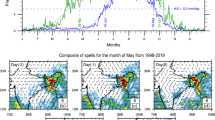Abstract
Multi-scale interactions between El Niño–Southern Oscillation and the Boreal Winter Monsoon contribute to rainfall variations over Malaysia. Understanding the physical mechanisms that control these spatial variations in local rainfall is crucial for improving weather and climate prediction and related risk management. Analysis using station observations and European Centre for Medium-Range Weather Forecasts Interim Reanalysis (ERA-Interim) reanalysis reveals a significant decrease in rainfall during El Niño (EL) and corresponding increase during La Niña particularly north of 2°N over Peninsular Malaysia (PM). It is noted that the southern tip of PM shows a small increase in rainfall during El Niño although not significant. Analysis of the diurnal cycle of rainfall and winds indicates that there are no significant changes in morning and evening rainfall over PM that could explain the north–south disparity. Thus, we suggest that the key factor which might explain the north–south rainfall disparity is the moisture flux convergence (MFC). During the December to January (DJF) period of EL years, except for the southern tip of PM, significant negative MFC causes drying as well as suppression of uplift over most areas. In addition, lower specific humidity combined with moisture flux divergence results in less moisture over PM. Thus, over the areas north of 2°N, less rainfall (less heavy rain days) with smaller diurnal rainfall amplitude explains the negative rainfall anomaly observed during DJF of EL. The same MFC argument might explain the dipolar pattern over other areas such as Borneo if further analysis is performed.























Similar content being viewed by others
References
Banacos PC, Schultz DM (2005) The use of moisture flux convergence in forecasting convective initiation: historical and operational perspectives. Weather Forecast 20:351–366
Chang CP, Wang Z, Ju J, Li T (2004) On the relationship between western maritime continent monsoon rainfall and ENSO during northern winter. J Clim 17:665–672
Cheang BK (1993) Interannual variability of monsoons in Malaysia and its relationship with ENSO. Proc Indian Acad Sci Earth Planet Sci 102:219
Chen T-C, Tsay J-D, Yen M-C, Matsumoto J (2013) The winter rainfall of Malaysia. J Clim 26:936–958
Dai A (2001) Global precipitation and thunderstorm frequencies. Part II: diurnal variations. J Climate 14:1112–1128
Dee DP et al (2011) The ERA-interim reanalysis: configuration and performance of the data assimilation system. Q J R Meteorol Soc 137:553–597
Efron B, Tibshirani R (1986) Bootstrap methods for standard errors, confidence intervals, and other measures of statistical accuracy. Stat Sci 1:54–75
Haylock M, McBride J (2001) Spatial coherence and predictability of Indonesian wet season rainfall. J Clim 14:3882
Huang B et al (2015) Extended reconstructed sea surface temperature version 4 (ERSST.v4). Part I: upgrades and intercomparisons. J Clim 28:911–930
Juneng L, Tangang FT (2005) Evolution of ENSO-related rainfall anomalies in Southeast Asia region and its relationship with atmosphere–ocean variations in Indo-Pacific sector. Clim Dyn 25:337–350
Lau N-C, Nath MJ (2000) Impact of ENSO on the variability of the Asian–Australian monsoons as simulated in GCM experiments. J Clim 13:4287–4309
McBride J, Haylock M, Nicholls N (2003) Relationships between the maritime continent heat source and the El Niño–Southern Oscillation phenomenon. J Clim 16:2905–2914
Mori S et al (2004) Diurnal land–sea rainfall peak migration over Sumatera Island, Indonesian maritime continent, observed by TRMM satellite and intensive Rawinsonde soundings. Mon Weather Rev 132:2021–2039
Oki T, Musiake K (1994) Seasonal change of the diurnal cycle of precipitation over Japan and Malaysia. J Appl Meteorol 33:1445–1463
Qian J-H (2008) Why precipitation is mostly concentrated over islands in the maritime continent. J Atmos Sci 65:1428–1441
Qian J-H, Robertson AW, Moron V (2010) Interactions among ENSO, the monsoon, and diurnal cycle in rainfall variability over Java, Indonesia. J Atmos Sci 67:3509–3524
Qian J-H, Robertson AW, Moron V (2013) Diurnal cycle in different weather regimes and rainfall variability over Borneo associated with ENSO. J Clim 26:1772–1790
Rauniyar SP, Walsh KJE (2013) Influence of ENSO on the diurnal cycle of rainfall over the maritime continent and Australia. J Clim 26:1304–1321
Richard S (2010) The diurnal variations of rainfall and winds over Malaysia. Dissertation, University of Hawaii at Manoa
Roads J (2003) The NCEP–NCAR, NCEP–DOE, and TRMM tropical atmosphere hydrologic cycles. J Hydrometeorol 4:826–840
Tangang F, Liew J (2004) Mechanisms of Malaysian rainfall anomalies. J Clim 17:3616–3622
Tangang F, Farzanmanesh R, Mirzaei A, Supari ES, Jamaluddin AF, Juneng L (2017) Characteristics of precipitation extremes in Malaysia associated with El Niño and La Niña events. Int J Climatol 37:696–716
Wong CL, Venneker R, Uhlenbrook S, Jamil ABM, Zhou Y (2009) Variability of rainfall in peninsular Malaysia. Hydrol Earth Syst Sci Discuss 6:5471–5503
Acknowledgements
This research was funded by the Jabatan Perkhidmatan Awam Malaysia (JPA) and the ARC Centre of Excellence for Climate System Science (ARCCSS). We are grateful to the Malaysian Meteorological Department for generously providing the hourly data for the purpose of this study. We thank the anonymous reviewers for their insightful comments on the manuscripts.
Author information
Authors and Affiliations
Corresponding author
Rights and permissions
About this article
Cite this article
Richard, S., Walsh, K.J.E. The influence of El Niño–Southern Oscillation on boreal winter rainfall over Peninsular Malaysia. Theor Appl Climatol 134, 121–138 (2018). https://doi.org/10.1007/s00704-017-2262-y
Received:
Accepted:
Published:
Issue Date:
DOI: https://doi.org/10.1007/s00704-017-2262-y




